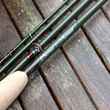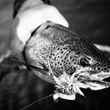Gar hold a special place in my angler’s heart. The connection stretches back to humid summer nights of catfishing with my dad on Arkansas River sandbars.
Cats were our target, but gar were frequent nibblers of our hooks stacked with minnows or slices of shad. Dad could always tell if it was a cat or a gar that had come-a-calling by watching the rod tip. Cats often stuck with ferocity—sharp bows in the rod that sometimes dislodged it from a forked driftwood prop and even sometimes drug the whole outfit into the churning river.
Gar were more subtle biters. The toothsome, armor-plated prehistoric beasts would start off with a few nibbles. The rod tip jiggled then stopped. Jiggled then stopped. Jiggled then stopped. And then a long, slow arc built up in the rod. “He’s moving off with it now,” Dad would say. Then the line would stop and few light twitches animated the tip. “He swallowed it,” Dad would say as he grunted a hookset and battled the gar. Often we weren’t properly prepared for a gar encounter and the battle didn’t last long. Even 50 pound-test monofilament couldn’t stand up to that bony mouth filled with needles. The line usually went limp after only a few runs and head shakes. And then one afternoon before a night of fishing, Dad bought some wire leaders. Game changer.
Though catfish were what we really wanted, we never turned down the opportunity to tangle with a piscine relic. And one muggy July night with half a moon hanging hazy and lazy in the sky, I tangled with Leviathan. It was Leviathan to a 10 year old, anyway. I don’t recall how many minutes I wrestled the longnose gar, but when its cream-colored belly finally slid up on the sand at my feet it was by handlining. My Shimano reel was shot, gears stripped and reduced to nothing more than a paperweight. The gar was long as I was tall. It was a true tackle-busting river monster, full of primal mysteries that I desperately wanted to know.
I still feel the same way about gar. They get a bum rap for lots of ignorant reasons, but they command my respect for the same reasons they did when I was a kid — river monster mystique and feisty attitudes on the hook. I’ve tangled with a few on the fly rod, but it always ends the same way it used to end for Dad and me with limp line and disappointment.
Tackle solutions for razor-mouthed quarry aren't something new, but fly anglers have always had less to choose from, as many of the materials used by conventional anglers are too stout and heavy for most fly rigs. Fly and other brands have offered a few wire materials that get the job done, but none have ever approached the toothy critter game as ardently as Scientific Anglers currently is—with a lineup that includes 5 different application-specific, ready-to-roll leaders and 2 different wire materials aimed specifically at fly anglers.
My go-to so far this spring has been ambiguous-but-aptly named Toothy Fish leader. I’ve not hooked a gar on the leader yet. It’s not for lack of trying. High water has squashed a lot opportunities this spring and when I have found gar they’ve been scattered among the riprap with gushing current. The Toothy Fish has held up to the abrasive rock even as I’ve done my damnedest to wedge it between boulders and slice it on jagged outcrops. The nickel titanium wire section has remained straight as the proverbial arrow and will always be rust free because nickel doesn’t rust. Kudos to SA for using components that endure. A heavy-duty snap closure finishes out the system and I’ve yet to pull a fly off even after numerous hangups.
Toothy Fish comes in two options, both with 20-pound butt section but either 25- or 45-pound wire and it’s a 7.5’ tapered leader. The 25-pound version will handle smaller gar and bowfin with ease. I’ll break out the 45-pounder for those sultry, coming-soon summer afternoons when porpoising four-foot longnose gar are everywhere I look in the oxbows and sloughs.
On a 7’ 11’ St. Croix Bass MOJO 7-weight rod, short range casts with the Toothy Fish have shown no drop off in accuracy, and it turns my big hollow flies tied on 3/0 circle hooks with ease. But longer reaches—50 feet or more—are a little dicey. I think this inconsistency can be overcome with familiarity. The wire leader simply feels different than my usual 1X and 0X straight tippet, and getting used to this different feel will take a little time. Castability is what we should be asking for in any wire leader. There’s no doubt that the nickel wire will hold up to teeth. The question is: Can it still be castable? The Toothy Fish is.
Other SA products geared toward fish with fearsome chompers include Predator leaders with a stainless steel wire and single barrel sleeves for securing a fly. And then the Esox Special and Figure Eight, both with an obvious nod to the pike and muskies, both with nickel wire. The Esox Special comes with a 40-pound fluorocarbon butt section. The Figure Eight is equipped with a 50-pound fluorocarbon butt to withstand those smashing boatside strikes on the last ditch effort of a cast. But I think they’d both do nicely attached to a 9-weight line wetted in south Arkansas or Texas, in waters haunted by alligator gar that would consider northern pike as an appetizer and maybe a musky as one course.
Southern River monsters be forewarned: I’m loaded for gar this summer.
































Comments
Shane replied on Permalink
A good read.
Pages